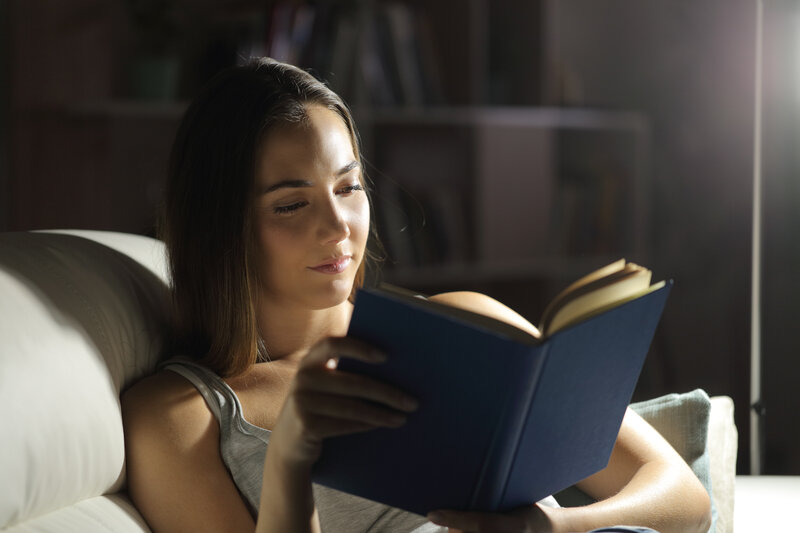Can Reading In The Dark Affect Your Vision?

Many of us grew up hearing how reading in the dark would ruin our eyes, and we may be passing that same myth on to others. No evidence indicates that reading in a poorly lit space - or in the dark - causes vision loss.
However, reading without proper lighting can negatively impact vision in other ways, so we advise reading with adequate lighting whenever possible.
Five Ways Reading In The Dark Can Negatively Affect Vision
Here are five ways that reading in the dark or with the wrong lighting (backlit screens, glaring light, too bright light, etc.) can negatively affect your eyes and vision. You’ll be more prone to any of the following symptoms when you’re tired, sick, during allergy season, after spending too much time in the sun or snow without adequate eye protection, or while fighting the onset of an eye infection.
Eye strain
Without adequate reading light, the eyes must work harder to see the letters on the page or screen. This puts you at risk for eye strain, and that has its own side effects, like:
- Tender or sore eye muscles.
- Irritated eyes.
- Fatigue.
- Difficulty concentrating.
- Red or watering eyes.
By ensuring you read by sufficient, warm light, you mimic the natural, dappled-daylight setting our eyes need to read or concentrate on without straining.
Dry eyes
Eye strain can be a catalyst for dry eyes or can exacerbate existing cases of dry eye. This condition is increasingly common now that most of us spend significant time reading or working on screens (people blink far less when staring at a screen, leading to dry eyes).
The symptoms of dry eye include:
- A feeling that the eyes are constantly dry.
- Gritty sensations.
- Excessive watering (may be triggered by working on a screen, reading in poor light or for long periods of time, or when you’re tired).
- Red, irritated eyes.
- The constant urge to rub your eyes.
In most cases, you can keep the symptoms at bay by reading in healthy lighting, taking breaks at least every 20 minutes, and using lubricating eye drops regularly to keep the eyes hydrated and flushed of any irritants.
If dry eye symptoms cannot be managed on your own, schedule an appointment with your optometrist so we can see what else can be done to minimize discomfort.
Red or irritated eyes
Anytime the eyes are strained they run the risk of being red (bloodshot) and irritated. This likelihood is increased if you’re already tired or not feeling well. So, for example, if you like to read before bed but notice that you wake up with red and irritated eyes - despite a good night’s sleep - it may be that you need to change the lighting situation.
Increased fatigue and difficulty concentrating
Tired eyes make you feel sleepy and fatigued. They want to close so they can rest. So, the more you read in the dark, the more it can affect your vision during the day. And, the more days in a row your eyes feel strained, the more challenging time you’ll have focusing or concentrating at work or on daily tasks.
This can have a significant impact on children who can’t pay attention in school or may struggle to stay engaged during reading and writing work. This is why kids should have eye exams every year before school begins. Children with strained eyes are more likely to have behavioral issues or reading delays, which are signs that they might need glasses. In this case, their symptoms are 100% related to their vision issues - and nothing to do with their abilities or brain chemistry!
Reading in the dark and blurred vision
When experiencing eye strain, you may feel like you have diminished vision. Tired eyes can begin to see double or experience blurred vision. They may also have difficulty adjusting focus when moving between near and far vision.
If you’ve had an eye exam in the past calendar year (and aren’t due immediately for the next one) see if there’s any correlation between your blurred vision and reading with dim light. Even so, it’s always best to check in with your optometrist to ensure you aren’t experiencing sudden vision loss.
Optimize Lighting For Reading And Other Focused Tasks
So, now we’ve talked about the importance of healthy reading and task lighting. But what does that actually mean? Here’s what the American Academy of Ophthalmology (AAO) recommends:
- Having light exposure from the side or angle rather than the direct front/back/overhead. Using adjustable or angle-pose lights is great for your favorite reading areas because they can be continually adjusted as the natural light changes throughout the day/evening.
- Bright, filtered light is best (studies show that bright daylight stimulates the brain, which improves vision and focus). You should never read with an LED bulb less than 10 watts.
- Incandescent or LED lights are better than fluorescents, which can strain eyes with their rapid flickering.
- Purchase a variety of white, warm, yellow, natural/daylight, etc., bulbs and try them all. You may find some are more irritating or strain-producing than others, and you can return the others.
- You should experiment with the brightness on backlit screens to find the level of brightness that is the least straining for you.
- Don’t assume your phone or computer’s “dark mode” is the best. Some people find it strains their eyes more. Sometimes the combination of a dimmer screen and adequate lighting are the optimal combination.
Eye to Eye Family Vision Care Wants You To Remain In the Light
The team at Eye to Eye Family Vision Care knows how important healthy lighting is for vision and reading pleasure. Feel free to talk to us about the right light for your home, office, or bedroom. We want our patients to experience as much strain-free reading as possible.
Schedule an appointment so we can check your prescription, ensure everything is current, and answer any questions you have about eye and vision health.

